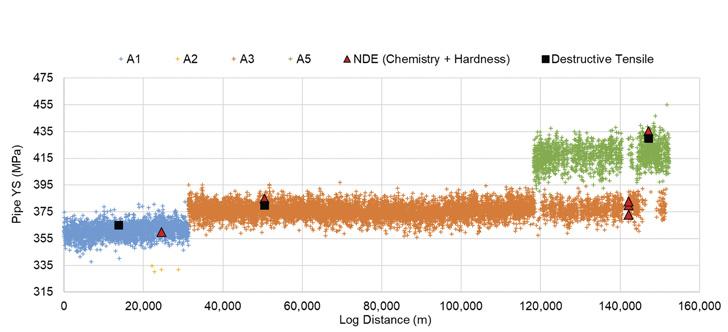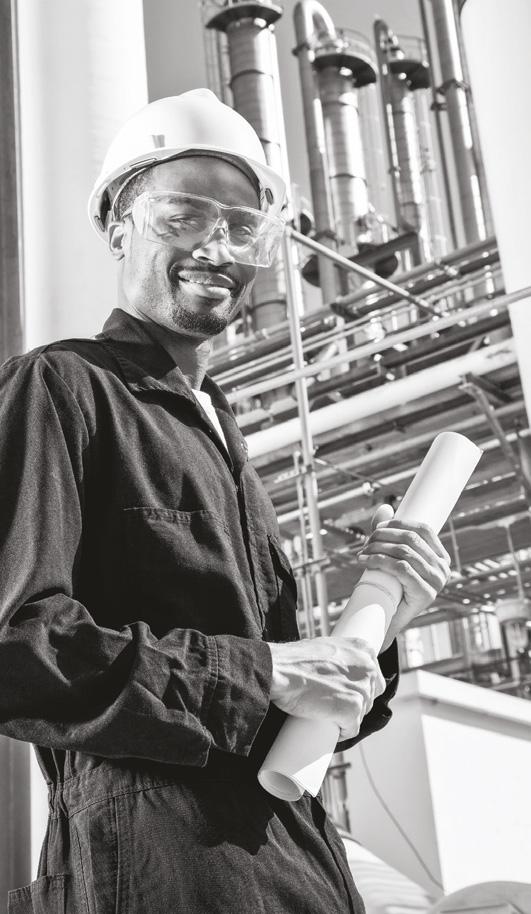
10 minute read
Colour-coded pipelines

Ollie Burkinshaw, ROSEN Group UK, and Simon Slater, ROSEN Group USA, discuss a combined ILI and data integration approach to determine the material properties of undocumented pipeline sections.

Material properties and attributes play a key role in the safe operation of pipelines. Over the life of an asset, records of material properties and attributes may be lost, or traceability of the documents may become uncertain. This is particularly likely for older assets, where original records only existed as hard copies and many factors may have led to reduced confidence over time, including changes in pipeline ownership or operator, office moves and staff changes. Even for pipelines where original records are thought to be complete or reliable, operators may have lost track of the various changes that have accumulated on the pipeline over time, such as repairs and replacements, re-routings, taps and so on.
Material verification is a general term for the process of re-establishing or confirming properties and attributes, including diameter, wall thickness, seam type, pipe grade and toughness. These parameters directly influence the design pressure and safe maximum allowable operating pressure (MAOP) of a pipeline. They are also critical inputs when calculating remaining strength and predicted failure pressure (PFP) for metal loss and crack-like features.
In the US, PHMSA recognised the importance of complete and accurate knowledge of material properties in new regulations that became effective in July 2020. These new regulations require operators of gas transmission pipelines to verify material properties where they are not evidenced by traceable, verifiable and complete (TVC) records to support MAOP and integrity assessments. The new regulations have sparked development of numerous novel technologies and processes that have made material verification approachable and cost-effective. Operators in other regions, outside the US, are following this lead and beginning to leverage these techniques in an effort to increasingly focus on gathering accurate material properties in support of safe pipeline operation.

A data integration approach to material verification Material verification activities should be structured and targeted so that they will provide a useful input into safe operation and integrity management (IM). By bringing multiple datasets together within a data integration approach, efforts can be focused to collect the specific properties that are needed in the right




locations. The key elements of this approach can be summarised as follows: ) Define pipe populations with shared properties and attributes.
) Determine the status of existing material property data for each population.
) Align existing integrity threats and susceptibility along the pipeline.
) Implement testing to verify the missing data required for each population.
This approach will be discussed in this article, alongside illustrative figures taken from a recent case study.
Pipe populations The first and perhaps most critical step to verifying material properties and attributes is to establish the different pipe materials present and their locations in the pipeline. These different pipe materials can be grouped into ‘populations’, a term that defines pipes with equivalent material properties and attributes. Once established, these populations mean the task of material verification becomes structured and manageable, in contrast to a ‘blind’ approach of collecting data and attempting to piece it together without context.
Establishing these populations can be challenging where construction records have been lost, meaning unknown pipe materials may exist in the pipeline. For unpiggable pipelines, significant effort must be placed on the records search, and operators may be left with significant gaps. For piggable pipelines with missing or unreliable records, the best solution is one based on inline inspection (ILI).
Inline inspection solutions ILI delivers up-to-date data on every pipe within the pipeline. By integrating multiple datasets from ILI, populations can be robustly identified. Changes in diameter or wall thickness and the presence or absence of a seam weld will directly reveal different pipe populations. However, many different pipe materials could still be present, with a wide range of grades or toughness properties.
To overcome this problem, ROSEN developed the RoMat PGS inline inspection service. It employs sensors based on a pre-magnetised eddy-current technology that is sensitive to metallurgical changes of parameters such as chemical composition and microstructure. By incorporating this dataset with other parameters measured by ILI within a data integration approach, different pipe materials can be identified – down to each individual pipe. Each pipe within the inspected pipeline section can be grouped into a population.
Figure 1 shows an example of a completed population assessment centered around the RoMat PGS service, where each data point represents the strength value determined for each pipe, and populations are colour-coded. The power of incorporating strength data into the population assessment is seen in the section between 120 000 m and 150 000 m: two pipe populations have been mixed together during construction, but each pipe can now be accurately separated into the correct population. This finding was only made possible by the incorporation of strength data from ILI. Because the metallurgical factors that determine the sensor response are also key determinants of pipe strength, the RoMat PGS service is able to use algorithms to determine yield strength (YS) and ultimate tensile strength (UTS) values for each pipe. In Figure 1, the reported strength values from each pipe can be immediately compared against the expected pipe grade of X52 (L360) to identify areas that clearly exceed requirements – as well as areas on which to focus additional testing and inspection. By considering the distribution of strength values within each population, a single ‘bestfit’ pipe grade can be assigned to each pipe population. For unknown or undocumented pipe populations, doing so provides valuable information without having to conduct excavations or remove pipe for destructive testing.
Integrating integrity threats By integrating feature data reported by ILI with information about the assigned populations, trends may be identified with respect to each population’s susceptibility to different integrity

Figure 1. Measured yield strength by log distance, colour-coded by population.
Figure 2. Features reported by EMAT-C, aligned with RoMat PGS populations.

threats. Susceptibility to certain integrity threats may be a function of the pipe population, depending on, for example, the deployed steelmaking and manufacturing processes or the seam type. Secondary factors such as coating type and quality may also be linked to different populations.
In this case study, the locations of crack-like features determined by ILI (circumferential EMAT) are shown in Figure 2 by dashed lines, overlaid and colour-coded to match the pipe population within which they are Figure 3. Annotated locations of completed material verification testing. contained. The vast majority of cracklike features are located within the blue and orange populations, and it is therefore critical to establish accurate toughness data for these Testing and inspection populations. Conversely, other populations contain no features, Although multiple parameters and material properties are so removing pipes from service for testing would provide little generally grouped under the term ‘material verification’, different benefit. approaches are necessary to verify each of these. This is why it is
Other integrity threats such as metal loss can also be essential to first understand what properties must be collected aligned. By overlaying all integrity threats, susceptibility can and in what locations. be defined in terms of specifically affected populations. This ILI provides the only solution for measuring data on every means an optimiSed strategy for testing and inspection can be pipe, making it an essential tool for deployment in piggable implemented to close out gaps in the data required to support a pipelines. The use of ILI to measure diameter and wall thickness fully representative assessment of these features. is well-established. The use of ILI to measure pipe grade is







Accurate • Tough • reliable
THE LEADING BRAND OF HOLIDAY DETECTION EQUIPMENT SINCE 1953

a novel technology, and the extent of validation required is dependent on a number of factors. Whether the pipe is seamless or welded can be identified reliably by ILI, but if the specific weld type must be identified, then validation is required for each undocumented population.
Populations, material properties and attributes determined by ILI can be used as standalone data where appropriate. Where required, the ILI data can be refined and supplemented using testing and existing data from records. Non-destructive testing techniques that can be used to measure properties and attributes in excavations are now established technologies, including the measurement of YS and UTS. The most established techniques (Frontics IIT and MMT HSD) provide yield strength measurements that have proven accuracy evidenced in literature and joint industry studies. Although destructive testing will always be the most accurate method, these non-destructive techniques are extremely valuable in establishing pipe grade where removing pipes from service is impractical.
There is currently no commercially available non-destructive technique able to measure toughness, but there are active efforts in the industry to realise this technology.
Bringing it all together Maximum value is obtained when considering testing and inspection data with respect to the pipe populations. In this way, efforts are most efficiently directed to risk reduction instead of duplicated or misplaced. With respect to this case study, in Figure 2 it was established that the blue and orange populations contained numerous crack-like features, with two features reported in the green population and no features identified in other populations. Destructive and non-destructive testing was implemented opportunistically at locations shown in Figure 3. Non-destructive data was used to characterise and evidence the differences between the different pipe materials. Destructive data was collected at locations shown by the black squares; by collecting data from only three locations, toughness data was established to support the populations that contain all crack-like features detected in the pipeline. Tensile testing was also used to validate that each of these three populations, which constitute the vast majority of the pipeline length, exceeds the expected grade of X52 (L360). Leveraging the population approach has significantly improved pipeline knowledge and reduced risk with only three data points. Continued testing over time will further establish the distribution of properties within each population.
Summary Through a combined approach using records review, ILI, population assessment, alignment of integrity threats and testing, an optimised approach can be implemented to verify pipeline material properties and attributes. For piggable pipelines, significant advancements can be made in the understanding of the pipeline and its material properties using ILI combined with only a handful of tests at excavations or from cutouts. Building on this foundation, further testing gathered opportunistically over time can lead to the attainment of in-depth knowledge and data supported by a defined statistical confidence for critical pipe populations and, where applicable, the achievement of regulatory compliance through an efficient and optimised strategy.
THE FUTURE OF CORROSION PREVENTION
Introducing AMPP, the Association for Materials Protection and Performance. After more than 70 years, NACE International and SSPC have united as the global authority for corrosion prevention knowledge. We are creating the future of materials protection and performance and leading the way for the industries we represent. AMPP members protect people and places around the world from corrosion, and together we are building a safer, protected, and preserved world.










